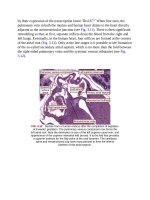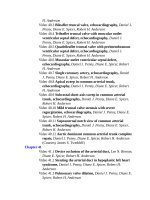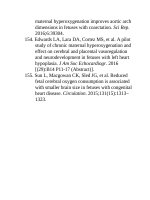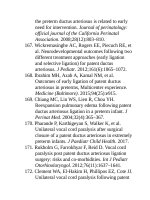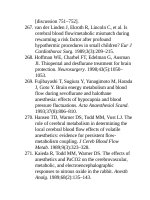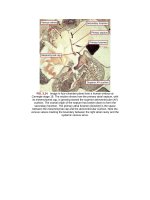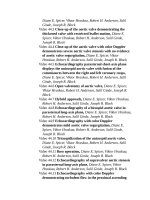Andersons pediatric cardiology 1082
Bạn đang xem bản rút gọn của tài liệu. Xem và tải ngay bản đầy đủ của tài liệu tại đây (104.54 KB, 3 trang )
Epidemiology
Thefactorsresponsibleforpersistentductalpatencybeyondthefirstdaysoflife
arenotfullyunderstood.Anincreasedincidenceisseeninthepremature
neonateduetophysiologicfactorsmorerelatedtoprematurityratherthanan
inherentabnormalityoftheduct.41Ininfantsbornatterm,persistentpatency
occurssporadically,butthereisincreasingevidencethatgeneticfactors,or
prenatalinfection,playaroleinmanychildren.Theestimatedincidencelies
between1in2000and1in5000livebirths.43–45Persistentpatencyoftheduct
accountsforapproximately12%ofallcongenitalcardiacmalformations.The
mostextensivestudyfromarelativelyhomogeneouspopulationwasthat
performedbyCarlgren,45whenhechartedtheincidenceofcongenitalcardiac
diseasetochildrenbornintheSwedishCityofGothenburg.Persistentductal
patencywasthethirdmostcommonlesionidentified,representing
approximately0.04%oflivebirths.Ifchildrenwiththeso-calledsilentductare
included,foundincidentallybyechocardiographyperformedforanotherreason,
theincidencemaybeashighas1in500.46Asignificantlyhigherincidenceof
ductalpatencyisalsoseenininfantsbornwithlowweight,patencybeingfound
inalmosthalfofinfantsweighinglessthan1750gatbirth,andupto80%of
thoseweighinglessthan1200g(seealsoChapter15).
GeneticFactors
Unlikeprematureinfants,asnotedearlier,wherepersistentductalpatencyis
moreoftenduetodevelopmentalimmaturity,intheinfantbornattermthereis
likelyastructuralabnormality.Thereisalsoanincreasedfrequencyinseveral
geneticsyndromes,suchasthosewithdefinedchromosomalaberrations,
examplesbeingtrisomy21,14q-and4p-syndromes,theRubinstein-Taybiand
CHARGEsyndromes,single-genemutationssuchasCarpenterandHolt-Oram
syndromes,andX-linkedmutationssuchasincontinentiapigmenti.Although
mostcasesofpersistentpatencyaresporadic,manyarealsobelievedtobedue
toamultifactorialinheritancepattern,withageneticpredispositionandan
environmentaltriggerthatoccursatavulnerabletime.47Femalespredominatein
aratioofgreaterthan2to1.Themodeofinheritanceappearstobeautosomal
recessivewithincompletepenetrance.48Inafamilyhavingonesiblingwitha
patentduct,thereisapproximatelya3%chanceofapersistentductina
subsequentoffspring47andahigherrisktotheoffspringgivenoneaffected
parent,some45timesgreaterthanthethatforthegeneralpopulation.Theriskto
furtherchildreninsibshipswheretwochildrenhavebeenaffectedisprobablyin
theorderof10%andincreaseswitheachaffectedchild.
InfectionandEnvironmentalFactors
Maternalrubelladuringthefirsttrimesterofpregnancy,particularlyinthefirst4
weeks,isassociatedwithahighincidenceofapersistentlypatentarterial
duct.49,50Thehistologyresemblesthatofaveryimmatureduct,withan
extensivesubendothelialelasticlamina,thoughttoretardanatomicsealing.51
Additionalenvironmentalfactorshavebeenreportedassociatedwithpersistence,
suchasinfetalvalproatesyndrome,52orafterthalidomide.53Apatentarterial
ductmaybemorelikelytobefoundininfantsbornathighaltitude.54
Pathophysiology
Persistentpatencyresultsinshuntingofbloodfromonesideofthecirculationto
theother,thevolumeofflowdependingonthelengthandinternaldiameterof
theductandonthesystemicandpulmonaryvascularresistances.Because
pulmonaryresistanceisusuallymuchlowerthansystemic,theflowisfromthe
aortatothepulmonarytrunk.Henceflowtothelungsisincreased,resultingin
leftatrialandleftventricularvolumeoverload.Iftheductiswidelypatent,flow
dependsentirelyontheratioofresistances.Rightventricularfailuremayoccur
inthepresenceofalargeductwithpulmonaryhypertensionorpulmonary
edema,andanelevatedleftatrialpressure.Inmostpatients,theductispartially
constrictedandthemajorfactorlimitingflow.Undertheseconditions,
pulmonaryarterialpressureisnormaloronlymildlyelevated.Symptomsand
clinicalfindingsarelargelydeterminedbythemagnitudeoftheshunt.
ClinicalFeatures
Mostpatientsareasymptomatic,thelesionrecognizedwithdetectionofthe
characteristicmurmur.Occasionally,theremaybeahistoryofprematurityor
asphyxiaduringbirth.Childrenwithlargeshuntsmayfailtothrive,experience
difficultywithfeedingduringinfancy,andfrequentlysufferrecurrentinfections
oftheupperrespiratorytract.Occasionally,congestiveheartfailuredevelops.
PhysicalExamination
Thereisretardedgrowthinapproximatelyone-thirdofchildren.Theyare
acyanoticintheabsenceofcomplicatingfactors.Theperipheralpulsesareeasily
palpable,witharapidupstrokeanddecay.Thereisawidenedpulsepressure,
withloweringofthediastoliccomponent.Arterialpulsationintheneckmaybe
prominentinthosewithlargeshunts.Theprecordialexaminationrevealsan
activecardiacimpulse,withtheforcefulcardiacapexdisplacedtotheleft.When
theshuntissmall,theonlyabnormalfindingmaybethemurmur.The
continuous,or“machinery,”murmuroftheuncomplicatedpersistentductisbest
heardintheleftinfraclaviculararea,althoughitisoccasionallymaximalatthe
thirdleftinterspace.Gibson's13descriptionofthemurmurasquotedbyTynan14:
Itbeginsquiteobviouslyafterthecommencementofthefirstsound.Itis
continuedduringthelatterpartofthatsoundandthewholeoftheshort
pause.Itpersiststhroughoutthesecondsoundanddiesawaygradually
duringthelongpause.Themurmurisdistinctlyroughandthrillinginits
character.Itbegins,however,somewhatsoftly,andincreasesinintensity
toreachitsacmejustabout,orimmediatelyafter,theincidenceofthe
secondsound,andfromthatpointwanesuntilitstermination.The
secondsoundcanbeheardtobeloudandclangingandwhencarefully
analyzeditisthepulmonarypartofthatsoundwhichisaccentuated.
Turbulentflowthroughtheductitselfcausesthemurmur.Additionalmurmurs
maybepresentduetoincreasedflowacrosstheaorticvalve,producingan
ejectionsystolicsound,andacrossthemitralvalve,givingadiastolicmurmur
withloudonset.Thesystoliccomponentofthecontinuousmurmurmaybe
transmittedintotheneck,maybeassociatedwithathrillinthesecondleft
intercostalspace,ormayincreaseinintensityduringinspirationduetoafallin
pulmonaryvascularresistance.Manypatientswithloudcontinuousmurmurs
alsohavemultiple“clanging”sounds.Thesearerelativelylocalizedtothe
pulmonaryareaandaremostfrequentinthesecondhalfofsystole,
correspondingtotheperiodofpeakflowwithintheduct.NeillandMounsey55
attributedthesesoundstotheturbulencecausedbythe“headon”collisionof
opposedflowfromtheductandtherightventricleandnamedthemeddysounds.
